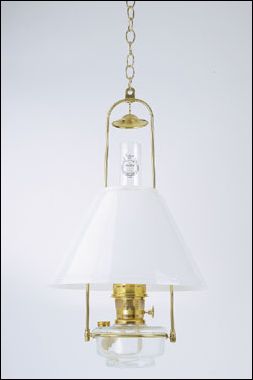 Aladdin lamps are very simple to use, but they do have their quirks. They might take a little bit of time to figure things out, but once you do, you’ll never use another oil lamp! Below are some tips that every Aladdin user should know to get the most out of their magical lamp.
Aladdin lamps are very simple to use, but they do have their quirks. They might take a little bit of time to figure things out, but once you do, you’ll never use another oil lamp! Below are some tips that every Aladdin user should know to get the most out of their magical lamp.
Fuel
- Only use Aladdin Lamp Oil (a highly refined kerosene), K-1 kerosene (clear only); KleanHeat is also acceptable (but may burn hotter, so use with caution); never use paraffin oil, colored or scented oil
- Paraffin oil is too thick to travel up the wick and will cause the burner to become clogged
- Colored, dyed or scented oil will not burn as well and may create more smoke and odors
- Always keep the oil in a clean container, away from sunlight and at room temperature to avoid condensation
- Every time you install a new wick (or every 6 months) it is good to dump out the fuel and replace with fresh if it’s been sitting for awhile
Filling Level
- Fill to about 1/2” below the filler cap–this will give you many hours of burning without the fuel expanding into the burner and causing a flooding condition, which will result in a lamp dripping fuel
- Most lamps holds about 1 quart of genuine Aladdin Lamp Oil, which will provide 10-12 hours of steady, bright light (brass lamps hold 1 1/2 quarts for about 15 hours of light)
- Never let the lamp burn dry with not enough fuel—this will burn the wick and not the fuel
- Filling in the Winter
- The fuel must be at room temperature before adding to the lamp—to do otherwise causes condensation to accumulate inside the bottom of the lamp bowl; the wick will then draw up this condensed water into the wick and cause it to sputter and burn unevenly, thus giving off a poor light
- Filling in the Summer
- Always keep the lamp at least half full during the summer months to avoid the wick drying out and check daily after use
- Lamp oil swells in the summer’s heat—if the lamp is filled to capacity, oil will flood the base of the burner and this will cause fuel spillage (burners have small holes in bottom to let fuel drain back out)
Altitudes
- For elevations of 3000’ or higher: use a high output (previously known as “high altitude”) chimney is required to increase the draft and flow of oxygen in order to operate at a “normal” performance; light boosters can also be added to the top of your standard chimney
- High output chimneys can be used at any altitude – at lower altitudes or sea level, the brightness can be increased up to 20% (this will use up more fuel than normal operation)
Wicks
- Keep wicks trimmed evenly—even the slightest unevenness on the top of the wick will cause the flame to spike
- Only use the provided wick cleaner, and only turn clockwise (do not go back and forth)—do not use scissors or a razor (except for stray threads)
- Do not touch the top of the wick, as this may deform the burning surface
- New wicks should be allowed to soak in fuel for about an hour (until fully soaked to the top), otherwise the wick will burn, and not the fuel, and this will cause damage to the wick and the lamp will not burn properly
- Before lighting, wick should only be turned up about 1/8” – 1/4”
- When lighting the wick, let the flame form a complete ring around the flame spreader, without turning up the wick too high
- The flame should be blue after placing the mantle, if it’s not, the burner may not be functioning properly
Burning the Lamp
- After first lighting, turn the wick up just slightly until the mantle just begins to glow slightly, and then stop to allow the lamp to warm up for about 20 minutes; after about 20 minutes the lamp will warm up to about 90% of its final temperature and then will begin to stabilize for up to an hour after the initial lighting
- Never turn the lamp to full brightness immediately—to do so will cause too much fuel to flow into the burner and upset the air-to-fuel ratio (94% air and 6% fuel) and will cause smoking and black spots on the mantle
- After the warm-up, when you turn the lamp up slowly, and the mantle begins to get black spots, turn it back slightly—this is the maximum brightness the lamp will achieve, or the “max set point”
- If black spots begin to form, turn the wick down slightly and they will burn off and the mantle will return to normal
- Always operate the lamp with at least part of the mantle glowing; turning flame down but not extinguishing can cause black smoke and soot after a while because the low flame heats the wick tube and there is not sufficient oxygen flow to cool the burner and more oil is vaporized than can be burned
Extinguishing the Lamp
- Always blow out the flame – only turning wick down until flame isn’t visible doesn’t mean that it is completely extinguished
- After blowing out the flame, turn the wick back up to make sure there is no flame, then turn back down again

